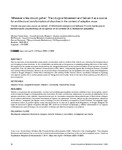Mostrar o rexistro simple do ítem
Wherever a few should gather: The Liturgical Movement and Vatican II as a source for architectural transformation of churches in the context of adaptive reuse
| dc.contributor.author | Vande Keere, Nikolaas | |
| dc.contributor.author | Plevoets, Bie | |
| dc.contributor.author | Goyvaerts, Samuel | |
| dc.date.accessioned | 2020-10-01T12:44:26Z | |
| dc.date.available | 2020-10-01T12:44:26Z | |
| dc.date.issued | 2020 | |
| dc.identifier.citation | Vande Keere, Nikolaas, Bie Plevoets & Samuel Goyvaerts. 2020. «‘Wherever a few should gather’. The Liturgical Movement and Vatican II as a source for architectural transformation of churches in the context of adaptive reuse». Actas de Arquitectura Religiosa Contemporánea 7: 36-51. https://doi.org/10.17979/aarc.2020.7.0.6289 | es_ES |
| dc.identifier.issn | 2659-8671 | |
| dc.identifier.uri | http://hdl.handle.net/2183/26283 | |
| dc.description.abstract | [Abstract] Due to a process of secularization many parish communities need to redefine their church use, reducing the liturgical space and bringing in other functions. In this contribution, we elaborate on the process of adapting existing churches to this reality. We argue that the spatial concepts developed by the Liturgical Movement in the context of Vatican II can become sources of inspiration. First, we define the relevant characteristics of the reform, instigated by figures like theologian Romano Guardini and architect Rudolf Schwarz. Second, we show how these characteristics can be applied in the case study of the Magdalena church in Bruges (Belgium). Rather than restoring the 19th century Gothic Revival church, we tried to translate its typology and layered quality into a contemporary space for liturgy and community, while at the same time opening up the church to its environment. | es_ES |
| dc.description.abstract | [Resumen] Debido a un proceso de secularización, muchas comunidades parroquiales necesitan redefinir el uso de su iglesia, reduciendo el espacio litúrgico e incorporando otras funciones. En esta contribución, elaboramos el proceso de adaptación de las iglesias existentes a esta realidad. Argumentamos que los conceptos espaciales desarrollados por el Movimiento Litúrgico en el contexto del Vaticano II pueden convertirse en fuentes de inspiración. Primero, definimos las características relevantes de la reforma, instigadas por figuras como el teólogo Romano Guardini y el arquitecto Rudolf Schwarz. En segundo lugar, mostramos cómo se pueden aplicar estas características en el caso de la iglesia de la Magdalena, en Brujas (Bélgica). En lugar de restaurar la iglesia neogótica del siglo XIX, tratamos de traducir su tipología y calidad contrastada en un espacio contemporáneo para la liturgia y la comunidad, al tiempo que abrimos la iglesia a su entorno. | es_ES |
| dc.language.iso | eng | es_ES |
| dc.publisher | Universidade da Coruña | es_ES |
| dc.relation.uri | https://doi.org/10.17979/aarc.2020.7.0.6289 | es_ES |
| dc.rights | Atribución-NoComercial-CompartirIgual 4.0 España | es_ES |
| dc.rights.uri | http://creativecommons.org/licenses/by-nc-sa/4.0/es/ | * |
| dc.subject | Adaptive Reuse | es_ES |
| dc.subject | Liturgical Movement | es_ES |
| dc.subject | Vatican II | es_ES |
| dc.subject | Community | es_ES |
| dc.subject | Research by design | es_ES |
| dc.subject | Reutilización adaptativa | es_ES |
| dc.subject | Movimiento Litúrgico | es_ES |
| dc.subject | Concilio Vaticano II | es_ES |
| dc.subject | Comunidad | es_ES |
| dc.subject | Investigación por diseño | es_ES |
| dc.title | Wherever a few should gather: The Liturgical Movement and Vatican II as a source for architectural transformation of churches in the context of adaptive reuse | es_ES |
| dc.title.alternative | Donde sea que unos pocos se reúnan: el Movimiento Litúrgico y el Vaticano II como fuente para la transformación arquitectónica de las iglesias en el contexto de la reutilización adaptativa | es_ES |
| dc.type | info:eu-repo/semantics/article | es_ES |
| dc.rights.access | info:eu-repo/semantics/openAccess | es_ES |
| UDC.journalTitle | Actas de Arquitectura Religiosa Contemporánea | es_ES |
| UDC.volume | 7 | es_ES |
| UDC.startPage | 36 | es_ES |
| UDC.endPage | 51 | es_ES |






